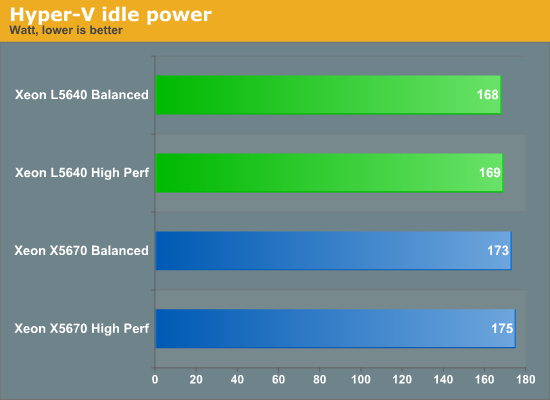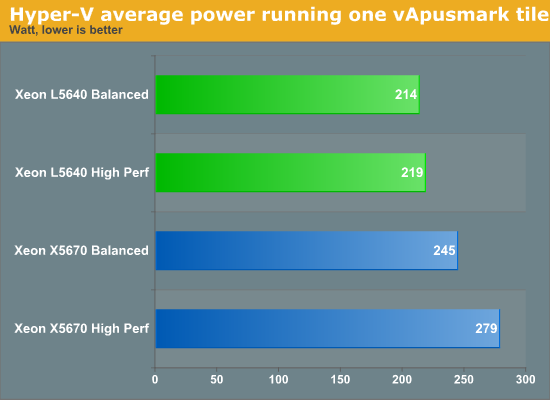Low Power Server CPUs: the energy saving choice?
by Johan De Gelas on July 15, 2010 4:54 AM EST- Posted in
- IT Computing
Idle power
We start measuring idle power running on the two most “used” Power Plans of Windows 2008 R2 Enterprise (Hyper-V enabled): Balanced or High Performance. We described both Power Plans and the resulting effect on the server here. This is the power consumption of the complete system, measured at the electrical outlet.

The Xeon family has made large steps forward in the power management department: fine grained clock gating and core power gating reduces power significantly. This however also results in a very small difference between the low power Xeon and the “Performance” Xeon. When running in idle, the Power management hardware (PCU) shuts down 5 cores and clockgates all components of the remaining core that are not necessary. The result of all these hardware tricks is that it hardly matters if you run those CPUs at 1.6 GHz or 2.26/2.93 GHz. The power plan “balanced” allows the CPU to scale back to 1.6 GHz, the power plan “high performance” never clocks lower than the advertised clockspeed (2.26/2.93 GHz). The amazing thing is that even at the higher clockspeed and voltage, the CPU only needs 2W more at the power outlet. So the real difference at the CPU level is even lower.
Let us put some load on those servers. One tile of vApus Mark I demands 12 virtual CPUs, and as we described before, it will demand about 25-45% of the dual CPU configuration.

If we calculate the average power, everything seems to be “as expected”. However, the problem with this calculation is that the some of the tests took longer than others. For example the test on the L5640 took about 66 minutes, while the Xeon X5670 needed only 59 minutes.

And that was a real surprise to us: as we were not loading the CPU to 100%, we did not expect that one test would take so much longer than the other. But you can clearly see that the fastest Xeon went more quickly to an idle state.










49 Comments
View All Comments
Zstream - Thursday, July 15, 2010 - link
It kills the AMD low power motto :(duploxxx - Thursday, July 15, 2010 - link
lol, all that you can say about this article is something about AMD. Looks like you need an update on server knowledge, Since the Arrival of Nehalem Intel has the best offer when you need the highest performance parts and when using Low power parts which give still the best performance. Since MC arrived things got a bit different mostly due to aggressive price for all mid value but still a favor to intel parts for highend and L power bins. Certainly in the area of virtualization AMD does very wellWhat is shown here should be known to many people that design virtual environments, Virtualization and low power parts don't match if you run applications that need cpu power and response all the time, L series can only be very useful for a huge bunch of "sleeping" vm's.
Interesting would be to compare with AMD, but 9/10 both low power and high power intel parts will be more interesting when you will only run 1 tile, the huge core amount lower ipc advantage will loose against the higher ipc/core of intel in this battle.
Zstream - Thursday, July 15, 2010 - link
Excuse me? I am quite aware of low power consuming chips. The point AMD has made in the past four to five years is that low power and high performance can match Intel's performance and still save you money. I have been to a number of AMD web conferences and siminars were they state the above.MrSpadge - Thursday, July 15, 2010 - link
Not sure if you're being sarcastic here, as it's obvious AMD would tell you this.
But regarding the actual question: you'd be about right if you compared K8 or Phenom I based Opterons with Core 2 based ones. And you'd be very right if you compared them to Phenom II. However, the performance of these Intels is being held back by the FSB and FB-DIMMs and power efficiency is almost crippled by the FB-DIMMs. But Nehalem changed all of that.
MrS
duploxxx - Friday, July 16, 2010 - link
4-5 years.... Nehalem was launched q12009 since then all changed. Before that Xeon parts suffered from FBDimm powerconsumption and FSB bottleneck and that is why AMD was still king on power/performance and was able to keep up with max performance. Nehalem was king, Istanbul was able to close the gap a bit but missed raw ghz and had higher power needs due to ddr2, again MC parts leveraged back this intel advantage and now there is a choice again, but L power still is king to Neh/Gulf.Penti - Saturday, July 17, 2010 - link
It invalidates low power versions of AMDs also. That's he's point I would believe.stimudent - Thursday, July 15, 2010 - link
Not really.If there can't be two sides to the story or a more diverse perspective, then it should not have been published. Next time, wait a little longer for parts to arrive - try harder next time.
MrSpadge - Friday, July 16, 2010 - link
A comparison to AMD would have been nice, but this article is not Intel vs. AMD!It already has 2 side: high power vs. low power Intels. And Johan found something very important and worthy of reporting. No need to blur the point by including other chips.
MrS
Zstream - Thursday, July 15, 2010 - link
I know we have the VMware results but could someone do an analysis on AMD / INTEL chips?For instance I can get a 12 core AMD chip or a 6 core/12 HT chip from Intel. Has anyone done any test with Terminal Servers or Real world usage of a VM (XP Desktop) with core count?
I would think that a physical 12C vs 6C impacts real world performance by a considerable large amount.
tech6 - Thursday, July 15, 2010 - link
Great work Anandtech - it's about time someone took the low power TCO claims to task.